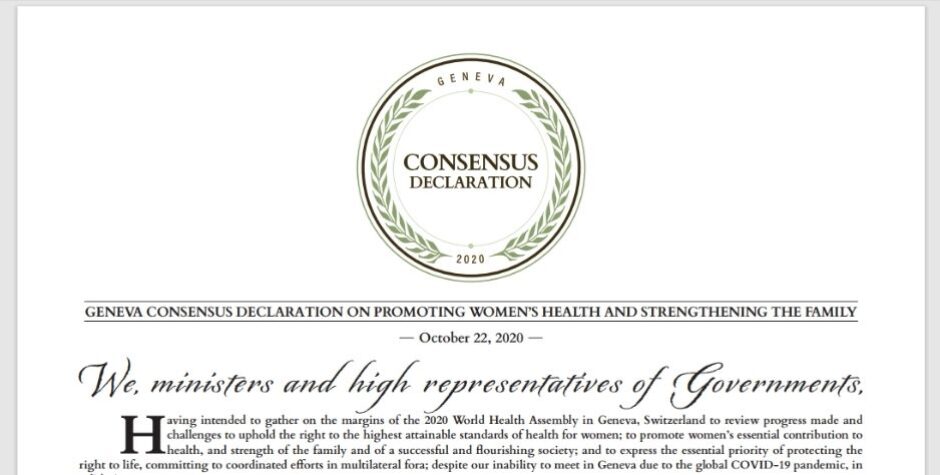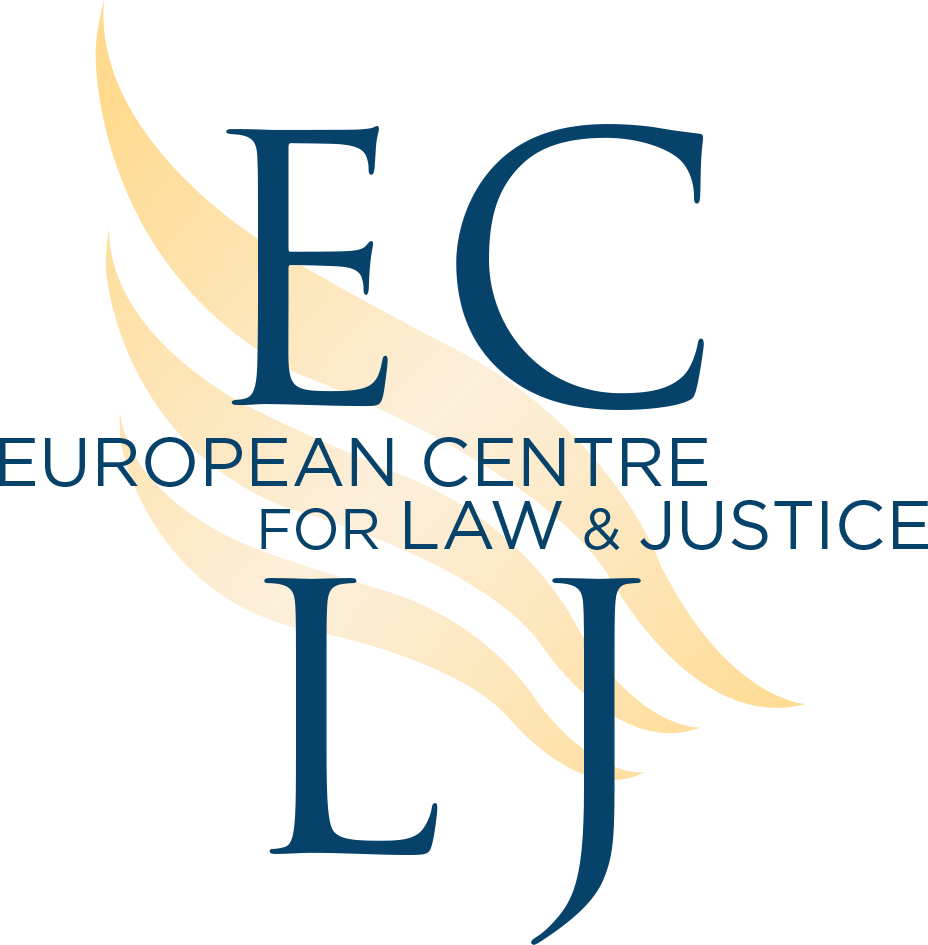

The Geneva Consensus Declaration: An Unprecedented International Pro-Life Coalition
The Geneva Consensus Declaration
On October 22, 2020, 35 States signed the Geneva Consensus Declaration on Promoting Women's Health and Strengthening Families (see below). These States from all regions of the world were brought together at the initiative of the United States in the wings of the World Health Assembly in Geneva (WHO). Based on international law, the Declaration recalls, inter alia, that the right to life is inherent to the human person,[1] that children need special protection before birth[2] and that “[abortion] in no case should be promoted as a method of family planning.”[3]
The list of signatories to this text has been growing steadily since October and represents 20% of the world's population. It includes three countries of the Council of Europe (Poland, Hungary and Georgia), many African States, the Arab States of the Gulf, Brazil, Paraguay, Belarus, Indonesia and Nauru (Oceania). This alliance of very diverse states is exceptional in geopolitical terms. Some signatory states are in fact strongly divided among themselves on other subjects. This is the case, for example, of the United States and Pakistan, Sudan and Southern Sudan, or Saudi Arabia and Qatar.
This Joint Declaration has been possible thanks to its preparation since 2016. As of September 2019, 19 states had already joined together to deny the existence of any right to abortion under international law or any obligation on states to facilitate or fund abortions. Such declaration is necessary, in order to counter the activism of pro-abortion NGOs and members of international organisations that are constantly trying to create a “human right to abortion”.
The current alliance of 35 states is promising and should be strengthened and have lasting influence at the United Nations.
This article can be read in full on Aleteia (in French only).
Geneva Consensus Declaration on Promoting Women’s Health and Strengthening the Family
We, ministers and high representatives of Governments,
Having intended to gather on the margins of the 2020 World Health Assembly in Geneva, Switzerland to review progress made and challenges to uphold the right to the highest attainable standards of health for women; to promote women’s essential contribution to health, and strength of the family and of a successful and flourishing society; and to express the essential priority of protecting the right to life, committing to coordinated efforts in multilateral fora; despite our inability to meet in Geneva due to the global COVID-19 pandemic, in solidarity, we
- Reaffirm “all are equal before the law,”1 and “human rights of women are an inalienable, integral, and indivisible part of all human rights and fundamental freedoms”;2
- Emphasize “the equal right of men and women to the enjoyment of all civil and political rights,”3 as well as economic, social, and cultural rights; and the “equal rights, opportunities and access to resources and equal sharing of responsibilities for the family by men and women and a harmonious partnership between them are critical to their well-being and that of their families”4; and that “women and girls must enjoy equal access to quality education, economic resources, and political participation as well as equal opportunities with men and boys for employment, leadership and decision-making at all levels;”5
- Reaffirm the inherent “dignity and worth of the human person,”6 that “every human being has the inherent right to life,”7 and the commitment “to enable women to go safely through pregnancy and childbirth and provide couples with the best chance of having a healthy infant”;8
- Emphasize that “in no case should abortion be promoted as a method of family planning”9 and that “any measures or changes related to abortion within the health system can only be determined at the national or local level according to the national legislative process”;10Reaffirm that “the child… needs special safeguards and care… before as well as after birth”11 and “special measures of protection and assistance should be taken on behalf of all children,”12 based on the principle of the best interest of the child;
- Reaffirm that “the family is the natural and fundamental group unit of society and is entitled to protection by society and the State”;13 that “motherhood and childhood are entitled to special care and assistance,”14 that “women play a critical role in the family”15 and women’s “contribution to the welfare of the family and to the development of society”;16
- Recognize that “universal health coverage is fundamental for achieving the Sustainable Development Goals related not only to health and well-being,”17 with further recognition that “health is a state of complete physical, mental and social well-being and not merely the absence of disease or infirmity”18 that “the predominant focus of health-care systems on treating illness rather than maintaining optimal health also prevents a holistic approach”;19 and that there are “needs that exist at different stages in an individual’s lifespan,”20 which together support optimal health across the life course, entailing the provision of the necessary information, skills, and care for achieving the best possible health outcomes and reaching full human potential; and
- “Reaffirm the importance of national ownership and the primary role and responsibility of governments at all levels to determine their own path towards achieving universal health coverage, in accordance with national contexts and priorities”,21 preserving human dignity and all the rights and freedoms set forth in the Universal Declaration of Human Rights.
Furthermore, we, the representatives of our sovereign nations do hereby declare in mutual friendship and respect, our commitment to work together to:
Ensure the full enjoyment of all human rights and equal opportunity for women at all levels of political, economic, and public life;
Improve and secure access to health and development gains for women, including sexual and reproductive health, which must always promote optimal health, the highest attainable standard of health, without including abortion;
Reaffirm that there is no international right to abortion, nor any international obligation on the part of States to finance or facilitate abortion, consistent with the long-standing international consensus that each nation has the sovereign right to implement programs and activities consistent with their laws and policies;
Build our health system capacity and mobilize resources to implement health and development programs that address the needs of women and children in situations of vulnerability and advance universal health coverage;
Advance supportive public health policies for women and girls as well as families, including building our healthcare capacity and mobilizing resources within our own countries, bilaterally, and in multilateral fora;
Support the role of the family as foundational to society and as a source of health, support, and care; and
Engage across the UN system to realize these universal values, recognizing that individually we are strong, but together we are stronger.
1 United Nations General Assembly. (1948). “Universal Declaration of Human Rights” (Article 7). Paris.
2 United Nations Fourth World Conference on Women. (1995). “Beijing Declaration and Platform for Action” (Paragraph 9). Beijing.
3 United Nations General Assembly. (1966). “International Covenant on Civil and Political Rights” (Article 3). New York.
4 Ibid. United Nations International Conference on Population and Development. (1994). “Programme of Action of the International Conference on Population Development” (Sections 8.25 and 63). Cairo.
5 United Nations General Assembly. (2015). “Transforming our world: the 2030 Agenda for Sustainable Development” (Paragraph 20). New York.
6 United Nations General Assembly. (1948). “Universal Declaration of Human Rights” (Preamble). Paris.
7 United Nations General Assembly. (1966). “International Covenant on Civil and Political Rights” (Article 6.1). New York.
8 United Nations International Conference on Population and Development. (1994). “Programme of Action of the International Conference on Population Development” (Section 7.2). Cairo.
9 Ibid. Section 8.25.
10 Ibid.
11 United Nations General Assembly. (1959). “Declaration on the Rights of the Child” (Preamble). New York.
12 United Nations General Assembly. (1966). “International Covenant on Economic, Social and Cultural Rights” (Article 10[3]). New York.
13 United Nations General Assembly. (1948). “Universal Declaration of Human Rights” (217A [III], Article 16(3)). Paris.
14 United Nations General Assembly. (1948). “Universal Declaration of Human Rights” (217A [III], Article 25[2]). Paris.
15 United Nations Fourth World Conference on Women. (1995). “Beijing Declaration and Platform for Action” (Annex II, Paragraph 29). Beijing.
16 Ibid.
17 United Nations General Assembly. (2019). “Political declaration of the high-level meeting on universal health coverage” (Paragraph 5). New York.
18 International Health Conference. (1946). “Constitution of the World Health Organization.” New York.
19 United Nations General Assembly. (2000). “Further actions and initiatives to implement the Beijing Declaration and Platform for Action” (Paragraph 11). New York.
20 United Nations Economic and Social Council. (1999). “Commission for Social Development: Report on the thirty-seventh session” (Chapter 1 [Annex, Paragraph 3], in reference to Programme of Action of the World Summit for Social Development). New York.
21 United Nations General Assembly. (2019). “Political declaration of the high-level meeting on universal health coverage” (Paragraph 6). New York.
[1] Preamble of the 1948 Universal Declaration of Human Rights.
[2] Preamble of the 1959 Declaration of the Rights of the Child, recalled in the 1989 International Convention on the Rights of the Child.
[3] International Conference on Population and Development, "Programme of Action of the International Conference on Population and Development," 1994, Cairo, section 8.25).












